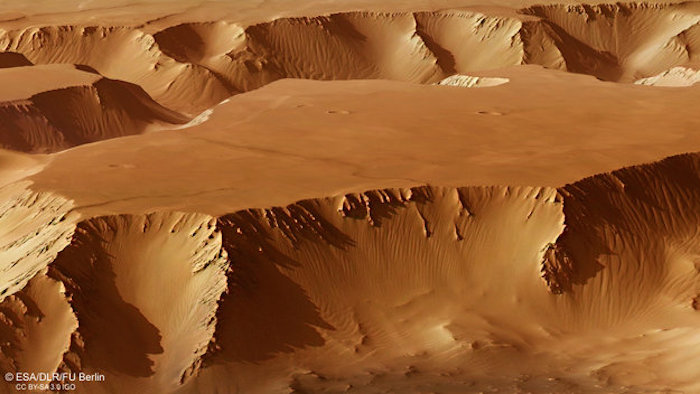.

This block of martian terrain, etched with an intricate pattern of landslides and wind-blown dunes, is a small segment of a vast labyrinth of valleys, fractures and plateaus.
The region, known as Noctis Labyrinthus – the “labyrinth of the night” – lies on the western edge of Valles Marineris, the grand canyon of the Solar System. It was imaged by ESA’s Mars Express on 15 July 2015.
It is part of a complex feature whose origin lies in the swelling of the crust owing to tectonic and volcanic activity in the Tharsis region, home to Olympus Mons and other large volcanoes.
As the crust bulged in the Tharsis province it stretched apart the surrounding terrain, ripping fractures several kilometres deep and leaving blocks – graben – stranded within the resulting trenches.
The entire network of graben and fractures spans some 1200 km, about the equivalent length of the river Rhine from the Alps to the North Sea.
The segment presented here captures a roughly 120 km-wide portion of that network, with one large, flat-topped block taking centre stage.
.

Landslides are seen in extraordinary detail in the flanks of this unit and along the valley walls (most notable in the perspective view, top), with eroded debris lying at the base of the steep walls.
In some places, particularly notable in the lower-right corner of the plan view image (above), wind has drawn the dust into dune fields that extend up onto the surrounding plateaus.
Near-linear features are also visible on the flat elevated surfaces: fault lines crossing each other in different directions, suggesting many episodes of tectonic stretching in the complex history of this region.
.

.

This context image shows part of the Noctis Labyrinthus region of Mars that was imaged by the High Resolution Stereo Camera on ESA’s Mars Express on 15 July 2015 during orbit 14632 (outlined by the large white box). The region outlined by the inner white box provides the focus of an associated image release.
Quelle: ESA
4448 Views
